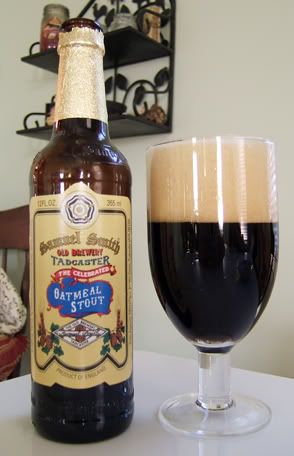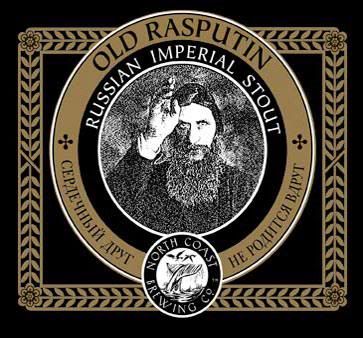 Today is Saint Patrick's day and, more importantly, I'm heading to New Orleans tomorrow. These two things are pretty much unrelated... I'm going to Louisiana to see some friends for spring break and I don't need a fucking holiday to tell me when to drink. Everyone knows the best time to drink is now, followed closely by later. However, Saint Patrick's Day and my trip do have one thing in common: they're both to be a celebration of my favorite kind of beer.
Today is Saint Patrick's day and, more importantly, I'm heading to New Orleans tomorrow. These two things are pretty much unrelated... I'm going to Louisiana to see some friends for spring break and I don't need a fucking holiday to tell me when to drink. Everyone knows the best time to drink is now, followed closely by later. However, Saint Patrick's Day and my trip do have one thing in common: they're both to be a celebration of my favorite kind of beer.I like my beer the way I like my women: dark, cold, slightly bitter, and filled with alcohol. Stouts (also called porters, but we'll get into that fucking subject later) are the darkest and among the most alcoholic of beers. Now, I'm not one to drink something just because it's loaded with booze... but when you're looking for something with a powerful taste, alcohol comes with the territory. I can't handle the generic, pissy beer taste of your Budweiser and Miller Lite. I want something with some balls. Whether you're a beer drinker or not, I urge you to give a stout a try. It really is a whole different league as far as flavor goes... and, hey, they even make some of them with chocolate.
The History of Stouts or The Best Way to Get Too Drunk to Carry Shit
The history of the stout/porter dates back all the way the 1700s. Like most booze history, the actual story is a little fuzzy at first... getting wasted for 300 years tends to change shit. Allegedly, the grandfather of the porter was actually a blend of ale, beer, and really fucking strong beer called Three Threads. This was a drink of the working alcoholic, primarily ship and street porters a.k.a. people whose job is to carry heavy shit. This was the primo drink for about thirty years, until a brewer managed to brew a single beer that had a similar taste (or it might have been brewed just because... this is one of those fuzzy areas) which he called Entire and the rest of England called porter after the folks that drank them. This same brewer was the first to age beer BEFORE it was sent out to the drinking public, lending even more punch to the brew.
Porters, along with dark, extremely alcoholic beers in general, were hot shit until about 1800, when the first pale ale was brewed. Tastes changed and porters got milder and milder, until most breweries stopped making them all together, leaving them behind as relics of a drunken century. With the micro-brew revolution, everything that was old is new again, and stouts are back in a big way.
So What's the Fucking Difference?
There isn't one. The term stout came from the most common adjective used to describe a porter, thus becoming a common term for the beverage itself. Stout and porter are no different than wine and vino or ice and frozen water. It's pretty much whatever the person who brews it wants it to be called... or at least the guy who wrote the label. I prefer to call them all stouts.
Shit You Shouldn't Believe
Dark beers, especially stouts, have a tendency to intimidate people. These pussies have invented and propagated many untruths about my beloved stouts, and I'm here to set the record straight:
- Myth One: Stouts are often brewed with dead animals floating in the barrel: Stouts are brewed pretty much the same way other beer is brewed... the big difference is the ingredient used (dark and roasted malts). Guinness is brewed with a fish byproduct called isinglass which doesn't make it into the final product, so the strictest of vegetarians might avoid it, but beyond that... this is shit.
- Myth Two: Stouts are Fattening: When compared to other beers, not really. There might be a few more calories, but it's not a whole hell of a lot. Wine is more fattening than 90% of stouts.
- Myth Three: Stouts are to be served warm: Nope. Beer (including stouts) is served cold pretty much worldwide. It's true that beer used to be served warm... hundreds of years ago before the advent of refrigeration and when many people thought tomatoes were poisonous. If you order a stout, it should be cold. If it is, get a new bartender.
Dry/Irish
The most popular stout by far is the dry or Irish stout. It's also the one most people are familiar with... Guinness. Founder/Lord and Savior Arthur Guinness brewed his first beer at St. James Gate brewery in 1759 and his first porter in 1778. Irish stouts have a coffee, toast-like flavor with a full, robust body. Guinness Extra Stout is my go-to beer and comprises about 77.4% of my total anatomy. Contrary to popular belief, Irish stouts aren't all that alcoholic when compared to others.
Imperial
Unlike most booze history, imperial stout (or Russian imperial stout) originated in a very specific place: Thrale's Brewery in London. In the late 1700s, they started to brew an extremely potent dark stout for export to the court of Russia's Catherine II. These are typically the most alcoholic stouts you'll encounter, coming it at around 8 or 9% ABV. Contrary to popular belief, the amount of alcohol has nothing to do with the Ruskies loving to get shit-housed... more alcohol allowed the brew to be transported to the Motherland without freezing en route. My favorite widely available Imperial is Old Rasputin by North Coast Brewing. It has a very bold flavor, with roasted malts, caramels, and even a hint of chocolate making an appearance.
Oatmeal
 When beer was near its infancy, oats were a common component. However, fermented oats are seriously fucking bitter, so the use of oats in beer died out shortly after the medieval period in Europe. There was a brief oat revival in the late 19th century when certain beers were touted as being good for you. Milk stouts, which contain lactose, were also popular around this time, though I'm not covering them here because they're pretty rare these days. Early 1900s oat beers actually contained very few oats, again because oats are bitter as fuck.
When beer was near its infancy, oats were a common component. However, fermented oats are seriously fucking bitter, so the use of oats in beer died out shortly after the medieval period in Europe. There was a brief oat revival in the late 19th century when certain beers were touted as being good for you. Milk stouts, which contain lactose, were also popular around this time, though I'm not covering them here because they're pretty rare these days. Early 1900s oat beers actually contained very few oats, again because oats are bitter as fuck.In the late 70s, oatmeal stouts got another resurgence, thanks mostly to English brewer Samuel Smith and world renowned alcohol journalist Michael Jackson (no, not THAT Michael Jackson). Today's oatmeal stouts are patterned after Sam Smith's original, and have lost the bitterness of their ancestors to form a very smooth, even taste. I've actually only ever had one oatmeal stout, Samuel Smith's original, and it's pretty fucking good.
Oyster
Historically, porters and oysters went together like hookers and Saturday night, which makes sense... ship porters drink stouts and eat oysters. Today's oyster stouts take it a step further and will sometime actually ferment the brew with oysters in the barrel. You might be thinking to yourself, "Man, that sure sounds like a gimmick to me." Yeah, well me too. Not all oyster stouts are born with oysters... some are called that just because they go well with oysters.
That's what you need to know about stouts and porters. There are a few more varieties, but most of those are self-explanatory: chocolate stouts have a chocolate flavor, coffee stouts have a coffee flavor, e.t.c. I urge you to go expand your beer drinking horizons. Like, right now.






No comments:
Post a Comment